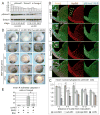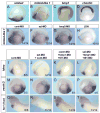Sizzled-tolloid interactions maintain foregut progenitors by regulating fibronectin-dependent BMP signaling
- PMID: 22863744
- PMCID: PMC3615545
- DOI: 10.1016/j.devcel.2012.07.002
Sizzled-tolloid interactions maintain foregut progenitors by regulating fibronectin-dependent BMP signaling
Abstract
The liver, pancreas, and lungs are induced from endoderm progenitors by a series of dynamic growth factor signals from the mesoderm, but how the temporal-spatial activity of these signals is controlled is poorly understood. We have identified an extracellular regulatory loop required for robust bone morphogenetic protein (BMP) signaling in the Xenopus foregut. We show that BMP signaling is required to maintain foregut progenitors and induce expression of the secreted frizzled related protein Sizzled (Szl) and the extracellular metalloprotease Tolloid-like 1 (Tll1). Szl negatively regulates Tll activity to control deposition of a fibronectin (FN) matrix between the mesoderm and endoderm, which is required to maintain BMP signaling. Foregut-specific Szl depletion results in a loss of the FN matrix and failure to maintain robust pSmad1 levels, causing a loss of foregut gene expression and organ agenesis. These results have implications for BMP signaling in diverse contexts and the differentiation of foregut tissue from stem cells.
Copyright © 2012 Elsevier Inc. All rights reserved.
Figures








Similar articles
-
Dorsal-ventral patterning: Crescent is a dorsally secreted Frizzled-related protein that competitively inhibits Tolloid proteases.Dev Biol. 2011 Apr 15;352(2):317-28. doi: 10.1016/j.ydbio.2011.01.029. Epub 2011 Feb 3. Dev Biol. 2011. PMID: 21295563 Free PMC article.
-
Syndecan4 coordinates Wnt/JNK and BMP signaling to regulate foregut progenitor development.Dev Biol. 2016 Aug 1;416(1):187-199. doi: 10.1016/j.ydbio.2016.05.025. Epub 2016 May 24. Dev Biol. 2016. PMID: 27235146 Free PMC article.
-
Sizzled is unique among secreted frizzled-related proteins for its ability to specifically inhibit bone morphogenetic protein-1 (BMP-1)/tolloid-like proteinases.J Biol Chem. 2012 Sep 28;287(40):33581-93. doi: 10.1074/jbc.M112.380816. Epub 2012 Jul 23. J Biol Chem. 2012. PMID: 22825851 Free PMC article.
-
The Chordin Morphogenetic Pathway.Curr Top Dev Biol. 2016;116:231-45. doi: 10.1016/bs.ctdb.2015.10.003. Epub 2016 Jan 7. Curr Top Dev Biol. 2016. PMID: 26970622 Review.
-
Neural induction and factors that stabilize a neural fate.Birth Defects Res C Embryo Today. 2009 Sep;87(3):249-62. doi: 10.1002/bdrc.20157. Birth Defects Res C Embryo Today. 2009. PMID: 19750523 Free PMC article. Review.
Cited by
-
Tril targets Smad7 for degradation to allow hematopoietic specification in Xenopus embryos.Development. 2016 Nov 1;143(21):4016-4026. doi: 10.1242/dev.141812. Epub 2016 Sep 15. Development. 2016. PMID: 27633996 Free PMC article.
-
Prolonged FGF signaling is necessary for lung and liver induction in Xenopus.BMC Dev Biol. 2012 Sep 18;12:27. doi: 10.1186/1471-213X-12-27. BMC Dev Biol. 2012. PMID: 22988910 Free PMC article.
-
Genomic integration of Wnt/β-catenin and BMP/Smad1 signaling coordinates foregut and hindgut transcriptional programs.Development. 2017 Apr 1;144(7):1283-1295. doi: 10.1242/dev.145789. Epub 2017 Feb 20. Development. 2017. PMID: 28219948 Free PMC article.
-
Xenbase: expansion and updates of the Xenopus model organism database.Nucleic Acids Res. 2013 Jan;41(Database issue):D865-70. doi: 10.1093/nar/gks1025. Epub 2012 Nov 3. Nucleic Acids Res. 2013. PMID: 23125366 Free PMC article.
-
Proper BMP Signaling Levels Are Essential for 3D Assembly of Hepatic Cords from Hepatoblasts and Mesenchymal Cells.Dig Dis Sci. 2015 Dec;60(12):3669-80. doi: 10.1007/s10620-015-3798-2. Epub 2015 Jul 15. Dig Dis Sci. 2015. PMID: 26173507 Free PMC article.
References
-
- Blitz IL, Shimmi O, Wunnenberg-Stapleton K, O’Connor MB, Cho KW. Is chordin a long-range- or short-range-acting factor? Roles for BMP1-related metalloproteases in chordin and BMP4 autofeedback loop regulation. Dev Biol. 2000;223:120–138. - PubMed
-
- Bovolenta P, Esteve P, Ruiz JM, Cisneros E, Lopez-Rios J. Beyond Wnt inhibition: new functions of secreted Frizzled-related proteins in development and disease. J Cell Sci. 2008;121:737–746. - PubMed
-
- Collavin L, Kirschner MW. The secreted Frizzled-related protein Sizzled functions as a negative feedback regulator of extreme ventral mesoderm. Development. 2003;130:805–816. - PubMed
Publication types
MeSH terms
Substances
Associated data
- Actions
Grants and funding
LinkOut - more resources
Full Text Sources
Medical
Molecular Biology Databases
Miscellaneous

